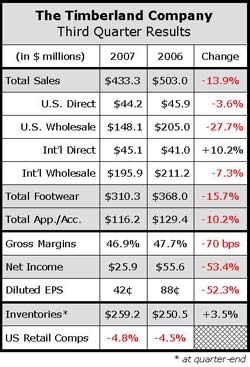Timberland saw another quarter of double-digit declines  as the companys boot and kids businesses continue to under-perform. Declines came from both the U.S. and Europe , with global footwear and apparel revenues showing double-digit revenue shortfalls. On a currency-neutral basis, Timberland sales declined 16% during the quarter. Timberland also announced another restructuring of the companys global sales force and product teams.
as the companys boot and kids businesses continue to under-perform. Declines came from both the U.S. and Europe , with global footwear and apparel revenues showing double-digit revenue shortfalls. On a currency-neutral basis, Timberland sales declined 16% during the quarter. Timberland also announced another restructuring of the companys global sales force and product teams.
Timberland's U.S. sales fell due to decreases in boots and kids sales, as well as declines in Timberland branded apparel as the business transitions to its new licensing partner. Timberland's
U.S. retail revenues were down due to weakness in sales of boots and apparel. Timberland saw a 5% decline in domestic comparable store sales.
U.S. wholesale revenues declined also because of slow boots and kids sales, impacted in part by Timberlands strategy to maintain the premium positioning of the Timberland brand by creating scarcity.
In its subsidiary business, Timberland saw double-digit growth in SmartWool and gains from the addition of IPATH.
International revenues were down, with Europe revenues dropping 8% as reported, or 13% on a constant-dollar basis. These declines were driven by lower boots, kids and apparel sales. Management said that there were declines in most European regions and the continued weakness in boots and kids was offset by strong growth with the distributor business.
Asia sales increased 8% as reported, or 7% on a constant-dollar basis. The region benefited from gains in Malaysia and Singapore , as well key distributor markets. The region saw growth in footwear and direct retail with a new store opening in Hong Kong, an outlet in Taiwan, and two shops in Malaysia .
TBL also saw modest declines in casual footwear and approximately $3 million in lost sales related to the recall of certain PRO steel-toe footwear. In spite of the recall, Timberland was able to land five of the top ten best selling work/utility boots for the trailing four week period, according to SportScan INFO .
Gross margins declined due to the impact of lower boots sales, which carry higher margins, in the U.S. and Europe . Increased levels of off-price sales and markdowns, higher comparable product costs, and the final phase-in of EU duties also contributed to lower gross margins. These factors were partially offset by favorable exchange rate fluctuations, which added 120 basis points to TBLs margins.
Operating expenses for the quarter, excluding restructuring charges, fell 3% to $151 million. Operating margin, excluding restructuring charges, was down 480 basis points to 12% for the quarter.
Timberland also announced a second realignment of its product management team. The company just completed a restructuring of this team in February of this year after COO & CFO Ken Pucker resigned. Going forward, instead of three distinct and separate product sales and marketing organizations Authentic Youth, Outdoor Performance and Casual – Timberland will operate as one, with specialty product and sales teams working together.
Gene McCarthy and Mike Harrison have been appointed co-presidents for the Timberland brand, while Gary Smith, previously the president of the outdoor performance group, will be responsible for the Enterprise Portfolio Group, which includes Timberland PRO, SmartWool, GoLite Footwear and other new brands.
For the fourth quarter, Timberland now anticipates continued revenue declines. Previous guidance was for flat sales, but now management is expecting a mid-single-digit sales shortfall compared to last year. Operating margins are expected to decline in the range of 200 basis points.
Full-year revenue is forecast to decline in the mid-single-digits. Lower boots and kids sales, higher levels of promotional activity, and increased product costs are expected to pressure operating margins, with expectations for full-year declines in the range of 400 to 450 basis points.
For 2008, Timberland is targeting mid-single-digit revenue declines for the first half, but the trend is expected to improve in the back half. There will also be improved operating contributions compared with first-half 2007.















